
$220 SAVE $130 = 37.0% Western Digital 16.0TB Western Digital Ultrastar DC HC550 3.5-in… in Storage: Hard Drives
|

|

|

|

|
Sprinter: Battery, Wiring Panel, Inverter as Installed
Photographer and cyclist and Mac expert and software engineer Lloyd Chambers is available for consulting on general Sprinter considerations at his usual consulting rates via phone, or in person in the Palo Alto, CA area. Save yourself hours and mistakes by discussing issues up-front. More about Lloyd....
Get your batteries and alternator and regulator (the whole kit!) from NationsStarterAlternator.com.

This page discusses the wiring setup in my 2017 Mercedes Sprinter photography adventure van, as installed by ADF Sprinters. A few things to note:
- Things got a little messy because I didn’t plan it out quite right. For starters, I uninstalled the Xantrex 3012 and its status panel (too big, unacceptable loss of critical space), replacing it with the Xantrex XC. So the wiring job is not as clean as if it had been wired and then not changed. Hence things like the hole in the panel near top right. Nor did I anticipate the total voltage losses from both battery and wiring, so wiring had to be doubled up (dual 1/0 gauge wiring).
- The van as shown is as yet unfinished (no insulation or walls).
- I ran some plugs up to my temporary table for things like USB ports. Later, when I install a permanent table, I might install those items in a wall panel. However, they are actually most convenient right on the table/desk.
- The table is temporary until I design the table/desk I want. I want field experience to decide on the exact form factor.
So where does all this battery power go? See Electric Accessories for the Sprinter.
Overview: battery, wiring panel, inverter
Below, the Lithionics 12V400A-5D-CTRL400 400 amp-hour battery and wiring panel and Xantrex XC inverter/charger.
The battery is installed on a custom stand fabricated by ADF Sprinters: I was on a tight schedule and they went from seeing the battery to having a stand fabricated within the space of a few hours—impressive both in their willingness to customize and the alacrity with which it was done.
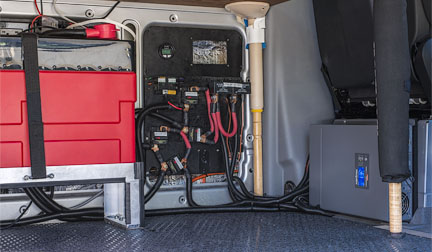
Battery and wiring panel
The wiring panel itself is discussed further below.
Below, the overall install showing the Lithionics 12V400A-5D-CTRL400 400 amp-hour battery, mounted on a custom-made stand with some clearance for feet and/or storage. Not shown in this image is the Xantrex XC inverter/charger, which is placed to the right, bolted to the driver seat box.
At top I’ve run DC power up to the top of the desk for a BESTEK 3-Socket 200W 12V/24V DC Cigarette Lighter Power Adapter with 5.2A 4-Port Car USB Splitter Charger @AMAZON and a BatPower Car Charger for MacBook and MacBook Pro, both excellent performers. Direct DC power is the most efficient way of using onboard battery power, because DC-to-AC conversion wastes about 15%.
At far left the grill is the white grill of an Aerus Apollo 2000 Infrared Space Heater @AMAZON, stored there for use when I need it. I used it to test the performance of the inverter and the alternator and the battery. The inverter and battery shrug off a 1500 watt load with no more than some not unpleasant fan noise from the inverter.
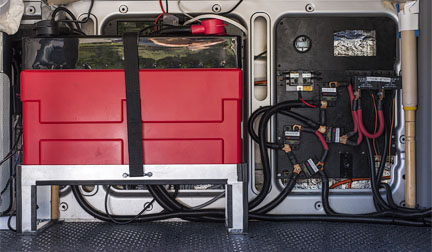
Wiring panel
Initially, I had not accounted for the voltage drop of the battery itself in addition to the cabling: under a 1500 watt load, the Lithionics battery drops to 12.8 volts and I was then seeing another 0.5 volt drop from the cabling; see Planning for Voltage Losses from Cabling and Battery. I had asked ADF Sprinters to keep extra cable length to the alternator, thinking I might want that length to wire to a 2nd alternator. That proved to be a voltage-drop problem with a single cable (19 feet long is way too long with 1/0 cable), so the cable was cut back to 12 feet long and also doubled up to use two 1/0 gauge cables from alternator/auxiliary battery to the battery.
Doubling up the cabling on the wiring panel and to/from the battery and keeping the single 1/0 cable to about 1.5 feet from the wiring panel to the inverter paid off: a 2X reduction in resistance by going to dual 1/0 cables from alternator to battery and from battery to wiring panel.
In addition, there was a 3X reduction in resistance from the wiring panel to the inverter achieved by shortening the cable from 5 feet to 1.5 feet. All of this attention to detail keeps inverter efficiency high, and stress on the inverter low, even at 1500 watt loads.
Under a 1500 watt load for 10 minutes, none of the contact areas even gets warm to the touch, a sign of more than ample conductance and minimal resistance. Voltage losses are nil for reasonable loads and only about 0.2V from battery to inverter under a 150 amp DC load—outstanding.
- At right are two Mercedes OEM solenoids which isolates the house battery (the red Lithionics battery) from the vehicle electrical system so that with the engine off, no power is drawn from the vehicle batteries. These solenoids allow charging current to pass through to the house battery.
- The junctions marked INVERTER and LITHIUM BATTERY are all fused and they can be flipped manually to cut the circuit.
- DC wiring and fuses are near top left.
- At very top is the Lithionics remote state panel.
- Cabling running from the bottom INVERTER junction downwards runs to the inverter. It is about 1.5 feet of 1/0 cable, which has minimal voltage drop even under amperage loads that would give the inverter fits. Minimal meaning less than 0.05 volt loss with a 150 amp current.
The single 1/0 gauge cable from the wiring panel to the inverter is more than sufficient since it is only about 1.5 feet long—enough for about 300 amps, way beyond what the 2000 watt Xantrex Freedom XC inverter can handle.
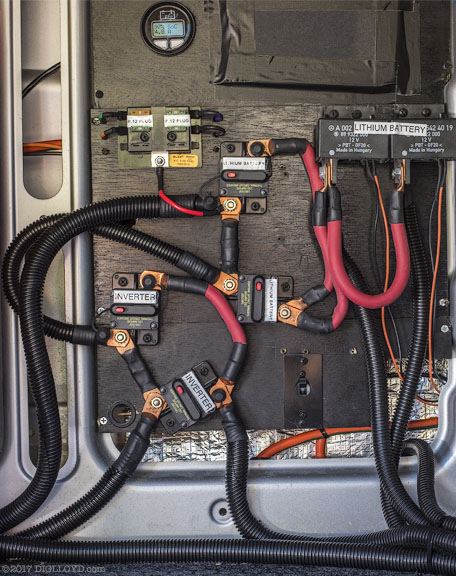
Xantrex XC inverter/charger
Below, the Xantrex XC inverter/charger which is bolted to the driver seat box. The wiring panel is to the left on the wall.
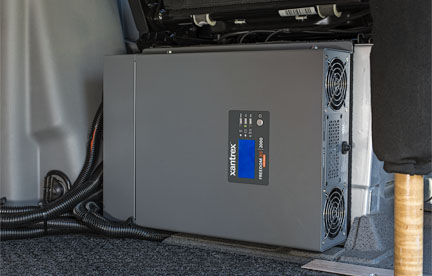
Double cables from alternator to battery
I wanted minimal voltage drop when charging via the alternator, so double 1/0 cables were run from the auxiliary battery (the Mercedes Sprinter is wired from alternator to starter battery to auxiliary battery). Net result: a drop of only 0.05 volts from the auxiliary battery to the terminals of the Lithionics battery. That’s about 12 feet of cabling running to the two solenoids on the wiring panel, then running to the battery.
The red color is a spray-on insulator liquid.
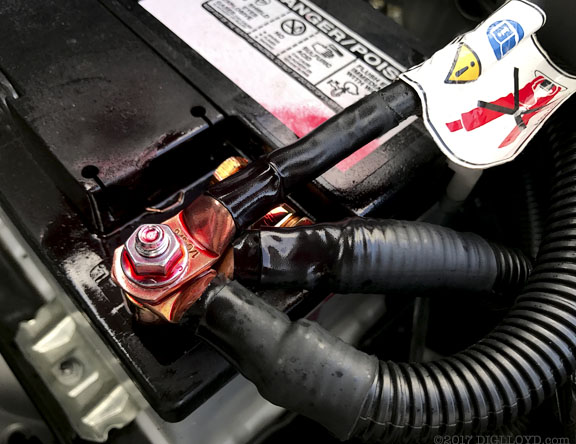
Using all that electricity
So where does all this battery power go? See Electric Accessories for the Sprinter.
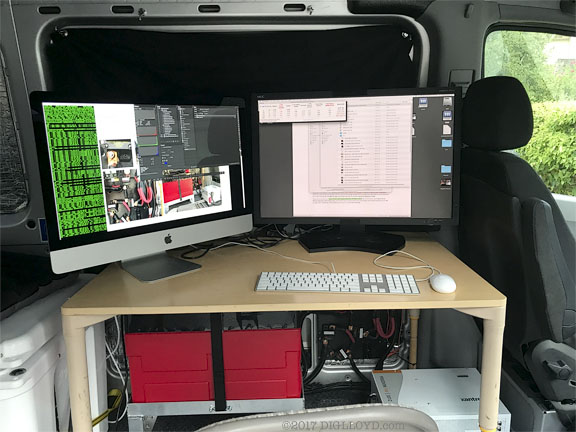
(temporary table, temporary curtains, as yet unfinished walls)
Seagate 22TB IronWolf Pro 7200 rpm SATA III 3.5" Internal NAS HDD (CMR)
SAVE $100



